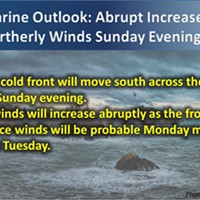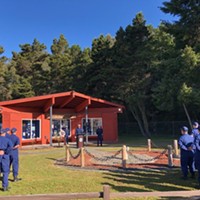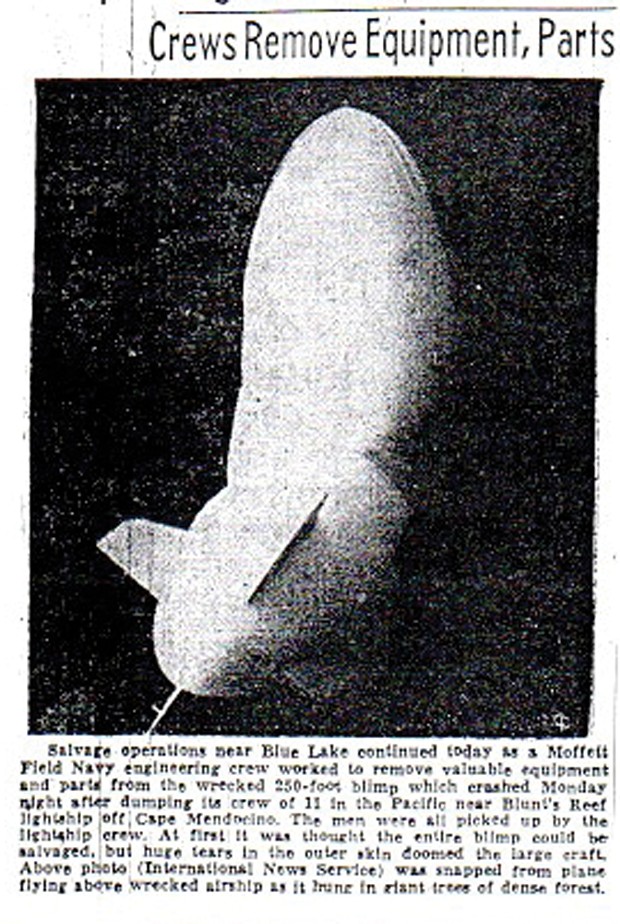[
{
"name": "Top Stories Video Pair",
"insertPoint": "7",
"component": "17087298",
"parentWrapperClass": "fdn-ads-inline-content-block",
"requiredCountToDisplay": "1"
}
]
The Humboldt Times, Sept. 14, 1946, ran the story of Bessie together with an aerial photo of the crashed airship. The caption reads, in part, "At first, it was thought the entire blimp could be salvaged, but huge tears in the outer skin doomed the large craft.
Something about Blunt's Reef, a jagged shard of rock three miles off Cape Mendocino, seems to breathe new vitality into otherwise lifeless craft. How else can you explain that, within a six-year period, two ships — one seaborne, one airborne — found new life there after being abandoned by their crews? It all happened long ago, during and immediately after World War II, but it's a pair of tales worth repeating here.
The United States declared war on Japan on Dec. 8, 1941, one day after the attack on Pearl Harbor, "the date which will live in infamy," as President Franklin Roosevelt put it in his speech to the nation. Twelve days later, the 7,000-ton tanker S.S. Emidio was en route from Seattle to San Pedro laden with ballast. Off Cape Mendocino, she was sighted by Japanese submarine I-17 and thus became the first victim of Japan's war in the Pacific. After being hit five times by shells from the sub's 5.5-inch deck gun, the Emidio crew started to abandon ship in lifeboats. Three men drowned when a shell hit a lifeboat and another two died when a torpedo fired from the I-17 exploded in the engine room. The 31 survivors out of the original crew of 36 made it to the Blunt's Reef lightship after rowing for 16 hours. A U.S. Coast Guard cutter then picked them up from the lightship and brought them to Eureka.
Meanwhile, despite her submerged stern, the Emidio stayed afloat, drifting north for several weeks until she ran aground on rocks off Crescent City and broke in two. The bow then drifted into Crescent City harbor, only to be salvaged for scrap in the 1950s. A nearby plaque, California Historical Landmark No. 497, commemorates the crewless ship.
Five years later, a 150-foot, L-type Navy blimp (or airship) had a similar reincarnation, this time, thankfully, with no loss of life. ZPK-99, "Bessie" to her friends, was returning south to the Mare Island Naval Base after completing an aerial photo mission near Crescent City. A mile off Cape Mendocino, she was caught in "a terrific downdraft." Despite the pilot's attempt to avert a crash by applying full throttle, the craft hit the water at an estimated 50 knots, throwing the pilot and co-pilot out of a smashed window, followed by six other men who were able to escape the blimp's gondola while it was still in the water. Now relieved of the weight of eight men, the blimp rose 50 feet into the air with three remaining crewmembers, who had the presence of mind (and courage) to jump into the water. Fortunately, a rancher saw the incident and called the Coast Guard, resulting in all 11 men being rescued by a raft from the nearby Blunt's Reef lightship.
Now crewless, Bessie apparently had a mind of her own. For the next three hours, she floated northeast, to finally "gently settle in a fold of the hills," according to the Humboldt Standard, watched by a crowd of Blue Lake residents. Not that gentle! The landing broke her in two when she hit trees and crashed into Minor's Quarry (owned by Isaac Minor, memorialized in the name of Arcata's 1914 theater) on Fickle Hill. By the time the USCG arrived on the scene that evening, looters had already made off with anything of value.
And that's how two plucky craft regained their élan vital after abandonment. Hearty thanks to Jerry Rohde for help with these two stories.
Barry Evans (he/him, [email protected]) believes helium-filled airships have a glorious future.
Speaking of...
-

It's Going to Get Gusty: Gale Force Winds Expected
Mar 28, 2021 -

Remembering the Lost Crew of Coast Guard 6549
Jun 7, 2019 - More »
more from the author
-
Doubting Shakespeare, Part 2: Problems
- May 2, 2024
-
Doubting Shakespeare, Part 1: Stratfordians vs. anti-Stratfordians
- Apr 25, 2024
-
A Brief History of Dildos
- Apr 11, 2024
- More »
Latest in Field Notes
Readers also liked…
-
Trouble on the Line: The Reality Part 2
- Nov 3, 2022

































